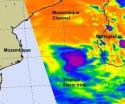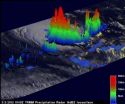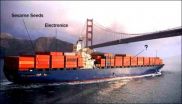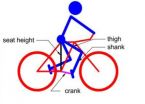(Press-News.org) Astronomers using data from NASA's Hubble Telescope have observed what appears to be a clump of dark matter left behind from a wreck between massive clusters of galaxies. The result could challenge current theories about dark matter that predict galaxies should be anchored to the invisible substance even during the shock of a collision.
Abell 520 is a gigantic merger of galaxy clusters located 2.4 billion light-years away. Dark matter is not visible, although its presence and distribution is found indirectly through its effects. Dark matter can act like a magnifying glass, bending and distorting light from galaxies and clusters behind it. Astronomers can use this effect, called gravitational lensing, to infer the presence of dark matter in massive galaxy clusters.
This technique revealed the dark matter in Abell 520 had collected into a "dark core," containing far fewer galaxies than would be expected if the dark matter and galaxies were anchored together. Most of the galaxies apparently have sailed far away from the collision.
"This result is a puzzle," said astronomer James Jee of the University of California in Davis, lead author of paper about the results available online in The Astrophysical Journal. "Dark matter is not behaving as predicted, and it's not obviously clear what is going on. It is difficult to explain this Hubble observation with the current theories of galaxy formation and dark matter."
Initial detections of dark matter in the cluster, made in 2007, were so unusual that astronomers shrugged them off as unreal, because of poor data. New results from NASA's Hubble Space Telescope confirm that dark matter and galaxies separated in Abell 520.
One way to study the overall properties of dark matter is by analyzing collisions between galaxy clusters, the largest structures in the universe. When galaxy clusters crash, astronomers expect galaxies to tag along with the dark matter, like a dog on a leash. Clouds of hot, X-ray emitting intergalactic gas, however, plow into one another, slow down, and lag behind the impact.
That theory was supported by visible-light and X-ray observations of a colossal collision between two galaxy clusters called the Bullet Cluster. The galactic grouping has become an example of how dark matter should behave.
Studies of Abell 520 showed that dark matter's behavior may not be so simple. Using the original observations, astronomers found the system's core was rich in dark matter and hot gas, but contained no luminous galaxies, which normally would be seen in the same location as the dark matter. NASA's Chandra X-ray Observatory was used to detect the hot gas. Astronomers used the Canada-France-Hawaii Telescope and Subaru Telescope atop Mauna Kea to infer the location of dark matter by measuring the gravitationally lensed light from more distant background galaxies.
The astronomers then turned to the Hubble's Wide Field Planetary Camera 2, which can detect subtle distortions in the images of background galaxies and use this information to map dark matter. To astronomers' surprise, the Hubble observations helped confirm the 2007 findings.
"We know of maybe six examples of high-speed galaxy cluster collisions where the dark matter has been mapped," Jee said. "But the Bullet Cluster and Abell 520 are the two that show the clearest evidence of recent mergers, and they are inconsistent with each other. No single theory explains the different behavior of dark matter in those two collisions. We need more examples."
The team proposed numerous explanations for the findings, but each is unsettling for astronomers. In one scenario, which would have staggering implications, some dark matter may be what astronomers call "sticky." Like two snowballs smashing together, normal matter slams together during a collision and slows down. However, dark matter blobs are thought to pass through each other during an encounter without slowing down. This scenario proposes that some dark matter interacts with itself and stays behind during an encounter.
Another possible explanation for the discrepancy is that Abell 520 has resulted from a more complicated interaction than the Bullet Cluster encounter. Abell 520 may have formed from a collision between three galaxy clusters, instead of just two colliding systems in the case of the Bullet Cluster.
A third possibility is that the core contained many galaxies, but they were too dim to be seen, even by Hubble. Those galaxies would have to have formed dramatically fewer stars than other normal galaxies. Armed with the Hubble data, the group will try to create a computer simulation to reconstruct the collision and see if it yields some answers to dark matter's weird behavior.
INFORMATION:
The Hubble Space Telescope is a project of international cooperation between NASA and the European Space Agency. NASA's Goddard Space Flight Center in Greenbelt, Md., manages the telescope. The Space Telescope Science Institute (STScI) in Baltimore, Md., conducts Hubble science operations. STScI is operated by the Association of Universities for Research in Astronomy, Inc., in Washington, D.C.
For images and more information about Abell 520's dark core, visit:
http://hubblesite.org/news/2012/10
For more information about dark matter, visit:
http://go.nasa.gov/dJzOp1
Dark matter core defies explanation in NASA Hubble image
2012-03-05
ELSE PRESS RELEASES FROM THIS DATE:
HollywoodSportsbook.eu Announces Its Own Unique March Madness Contest
2012-03-05
Hollywood Sportsbook (www.hollywoodsportsbook.eu) a leading online entertainment gaming site since 1997, today announced it will offer a month long promotion allowing players to pick the winners of certain NBA and college basketball games all month long.
Robert Evans, Hollywood's Director of Operations says, "Well here we are... the most exciting month for basketball. In addition to all the cool stuff we will have going on this month for the NCAA tournament, we hope this contest will float our players' boats as well..."
For each coming weekend in March, ...
NASA sees tropical storm Irina hit by wind shear, headed for Mozambique
2012-03-05
The AIRS instrument on NASA's Aqua satellite provided forecasters with an infrared look at what was happening "under the hood" of Tropical Storm Irina's clouds and saw two reasons why it temporarily weakened before moving into the Mozambique Channel and heading for landfall in Mozambique in a couple of days.
WHY DID IT WEAKEN?
NASA's Aqua satellite's Atmospheric Infrared Sounder (AIRS) instrument captured an infrared image of Tropical Cyclone Irina over the Mozambique Channel on March 1, 2012 at 0130 UTC (8:30 p.m. EST, Feb. 29). At that time, the strongest thunderstorms ...
NASA's TRMM satellite sees remnants of Tropical Cyclone 15S's 'difficult childhood'
2012-03-05
Tropical Cyclone 15S has had a difficult "childhood." It was born on March 1 and immediately dealt with a harsh environment. The cyclone weakened within 24 hours to a remnant low pressure area, and NASA's TRMM satellite revealed there was still some strength remaining in the storm.
The Tropical Rainfall Measuring Mission (TRMM) satellite passed over the remnants of Tropical Cyclone 15S in the South Indian Ocean on March 2, 2012 at 0140 UTC (8:40 p.m. EST, March 1). A rainfall analysis from TRMM's Microwave Imager (TMI) and Precipitation Radar (PR) instruments showed very ...
The future of plant science – a technology perspective
2012-03-05
Washington, D.C. -- Plant science is key to addressing the major challenges facing humanity in the 21st Century, according to Carnegie's David Ehrhardt and Wolf Frommer. In a Perspective published in The Plant Cell, the two researchers argue that the development of new technology is key to transforming plant biology in order to meet human needs.
Plants serve as the conduit of energy into the biosphere, provide food and materials used by humans, and they shape our environment. According to Ehrhardt and Frommer, the three major challenges facing humanity in our time are ...
When your ship comes in
2012-03-05
Every day, thousands of cargo containers from around the world pass through our nation's sea ports carrying items we need, and possibly some that are not so welcome: drugs, explosives, chemical, biological, or radiological weapons – even human cargo.
The possible concealment of such items in containers led lawmakers to call for the screening of all ocean cargo containers—thousands per port per day. The Department of Homeland Security's (DHS) U.S. Customs and Border Protection (CBP) is charged with the critical task of securing the country from terrorists and their ...
A new optimum design method of bicycle parameters for a specified person
2012-03-05
The optimum design of bicycle parameters has been explored by many scholars and institutes since bicycles were first invented. Professor Xin-Jun Liu and his group at Tsinghua University established a new way to design bicycle parameters according to the dimensions of the rider's body. They introduced a new perspective of the rider–bicycle system by considering the complete system as a mechanism. The group then established a new method for the optimum design of bicycle parameters from a completely theoretical basis, which may result in a new field of optimum design of bicycle ...
National Sleep Foundation poll explores transportation workers' sleep
2012-03-05
WASHINGTON, DC, March 3, 2012 – The people we trust to take us or our loved ones from place to place struggle with sleep, according to the National Sleep Foundation's (NSF) 2012 Sleep in America® poll. It is the first poll to ask transportation professionals, including pilots, train operators,* truck, bus, taxi and limo drivers about their sleep habits and work performance.
Pilots and train operators are most likely to report sleep-related job performance and safety problems.
The results of the poll are striking. About one-fourth of train operators (26%) and pilots (23%) ...
Ice hockey feels the heat in Canada
2012-03-05
The future of Canadian outdoor ice hockey – a sport synonymous with the country's culture – is being threatened by anthropogenic climate change, new research suggests.
As warmer winter temperatures restrict ice from freezing over, researchers believe the ice hockey stars of the future will have limited access to the frozen lakes and backyard rinks that have helped shape the careers of some of the greatest professional players, such as Wayne Gretzky; the Canadian considered to be the greatest of all time who started skating as a child on a rink in his backyard.
Evidence ...
Study shows brain flexibility, gives hope for natural-feeling neuroprosthetics
2012-03-05
Berkeley – Opening the door to the development of thought-controlled prosthetic devices to help people with spinal cord injuries, amputations and other impairments, neuroscientists at the University of California, Berkeley, and the Champalimaud Center for the Unknown in Portugal have demonstrated that the brain is more flexible and trainable than previously thought.
Their new study, to be published Sunday, March 4, in the advanced online publication of the journal Nature, shows that through a process called plasticity, parts of the brain can be trained to do something ...
Boosting cell production could help treat liver disease
2012-03-05
Scientists have shed light on how the liver repairs itself with research that could help develop drugs to treat liver disease.
Researchers at the Medical Research Council (MRC) Centre for Regenerative Medicine at the University of Edinburgh have discovered how to enhance the production of key cells needed to repair damaged liver tissue.
The study, published in the journal Nature Medicine, could help heal livers affected by diseases such as cirrhosis or chronic hepatitis.
Scientists were able to unpick the process of how different cells in the liver are formed.
When ...




